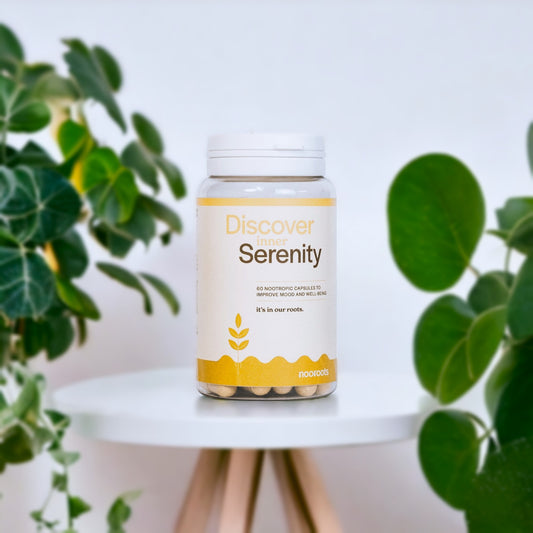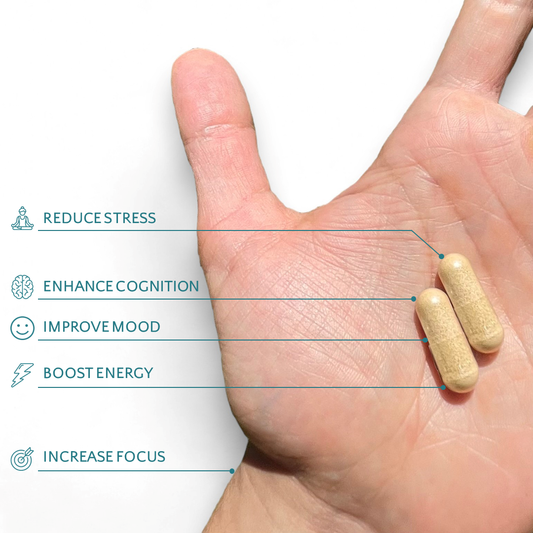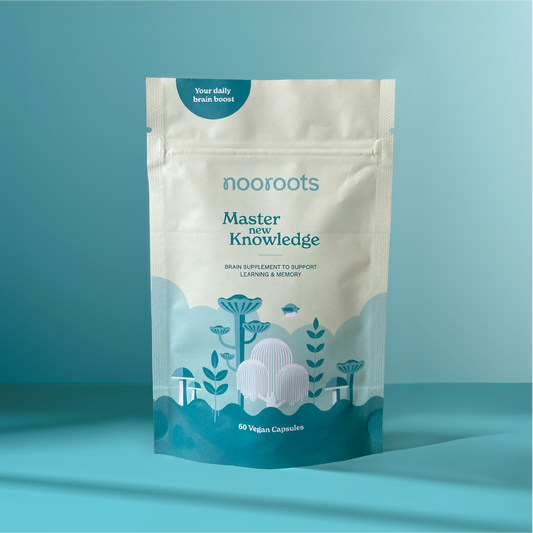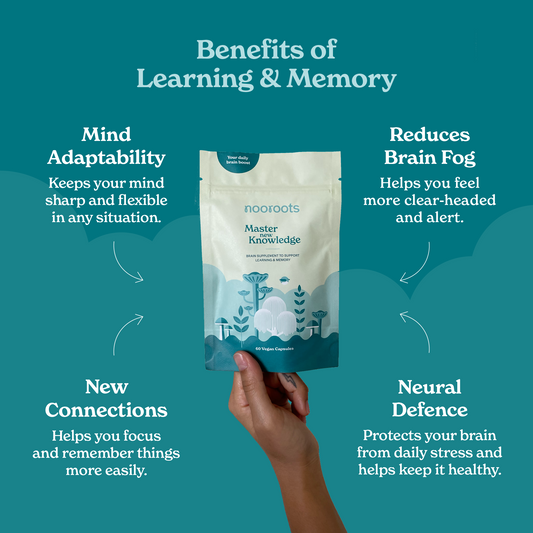Anxiety is one of the most widespread mental health conditions globally, characterized by persistent worry, restlessness, and physiological stress responses that can interfere with daily life and overall well-being. In the United States, anxiety disorders affect an estimated 18% of adults each year (National Institute of Mental Health, 2023), making them a leading cause of emotional distress and reduced quality of life.
While conventional treatments—such as selective serotonin reuptake inhibitors (SSRIs) and benzodiazepines—remain the clinical standard, they often present limitations. These include side effects such as fatigue, dizziness, and sexual dysfunction, as well as potential dependence with long-term use. For many individuals, such drawbacks have driven interest in alternative or complementary strategies that support mental balance more gently and sustainably.
Among these emerging approaches are natural compounds derived from plants and other bioactive sources that influence the brain’s stress and mood-regulating systems. These substances have gained attention for their ability to promote emotional resilience through mechanisms that may include modulation of neurotransmitters, reduction of oxidative stress, and stabilization of the hypothalamic-pituitary-adrenal (HPA) axis.
This article examines the scientific evidence behind the use of these natural compounds for anxiety management, identifies some of the most promising options, and provides practical insights into their potential role in supporting mental well-being.
Contents
- What is a Nootropic?
- The Neurobiology of Anxiety
- How Neurotransmitters Work in Anxiety?
- Treating Anxiety
- The Best Natural Nootropics for Anxiety Relief
- Using Natural Nootropics for Anxiety Management
- Importance of Healthy Lifestyle
Nootropics to Reduce Anxiety and Enhance Cognition

What is a Nootropic?
The term nootropic—derived from the Greek words nous (mind) and trepein (to bend or turn)—refers to substances that enhance mental performance, particularly in areas such as learning, memory, focus, and motivation. Originally introduced in 1972 by Romanian psychologist and chemist Corneliu E. Giurgea, the concept was intended to define a class of compounds that could safely and sustainably improve cognitive function without the side effects associated with traditional psychotropic drugs.
Giurgea proposed five key criteria for a compound to qualify as a nootropic:
- It should enhance learning and memory.
- It should increase resistance of learned behaviors or memories to disruption.
- It should protect the brain against physical or chemical injury.
- It should improve the efficiency of neuronal control mechanisms.
- It should lack the usual pharmacological side effects of psychotropic agents.
While these original parameters remain influential, the modern definition of nootropics has broadened considerably. Today, the term encompasses a diverse spectrum of substances—from pharmaceuticals and natural extracts to essential nutrients—that support various aspects of cognitive and emotional well-being.
Synthetic Compounds:
The earliest nootropic, Piracetam, was synthesized by Giurgea himself and became the prototype for a family of related compounds known as racetams. These compounds are believed to enhance neuronal communication and membrane fluidity, potentially improving memory and focus. More recent synthetic nootropics, such as Noopept and Modafinil, have been studied for their effects on attention, alertness, and cognitive endurance, though their use is typically regulated due to pharmacological potency and potential side effects.
Herbal and Nutritional Nootropics
Plant-based and dietary compounds form the foundation of natural nootropics, many of which have long histories in traditional medicine. Bacopa monnieri is known for enhancing memory and easing anxiety, while Rhodiola rosea supports stress resilience and mental performance. Ginkgo biloba and Panax ginseng are linked to improved circulation and cognitive endurance, and Ashwagandha (Withania somnifera) is valued for its calming and neuroprotective effects. Together, these botanicals offer a natural means of supporting mental clarity and emotional balance.
Nutrients and Fatty Acids
Certain vitamins, minerals, and lipids also exhibit nootropic properties by supporting metabolic and neurochemical processes essential to cognition. B vitamins (particularly B6, B9, and B12) contribute to neurotransmitter synthesis and homocysteine regulation, while omega-3 fatty acids—notably DHA—play a structural and anti-inflammatory role in maintaining neuronal health.
Amino Acids and Other Natural Compounds
Compounds such as L-Theanine, Acetyl-L-Carnitine, and creatine are frequently categorized as natural nootropics. L-Theanine, especially when paired with caffeine, promotes a calm yet alert mental state, whereas Acetyl-L-Carnitine supports mitochondrial energy metabolism in the brain. Creatine, more commonly associated with physical performance, also contributes to cerebral energy homeostasis and may enhance working memory under cognitive stress.
In sum, nootropics represent a wide-ranging class of compounds united by a common goal: to enhance cognitive function and mental resilience through mechanisms that support the brain’s natural physiology rather than overstimulate it.
The Neurobiology of Anxiety
The neurobiology of anxiety examines the complex interplay of brain structures, neurotransmitter systems, and physiological processes that underlie the experience and regulation of anxiety. Anxiety disorders—including generalized anxiety disorder (GAD), panic disorder, and social anxiety disorder—are characterized by excessive and persistent worry or fear that disrupts daily life and functioning. Understanding the biological mechanisms behind anxiety provides a foundation for identifying effective treatments and interventions.
Key Brain Structures in Anxiety
Anxiety arises from the coordinated activity of several brain regions that process emotional stimuli, assess threats, and regulate responses:
- Amygdala: The amygdala acts as the brain’s emotional alarm system, central to detecting and responding to threats. Overactivation of the amygdala has been consistently linked to heightened fear and anxiety responses (Etkin & Wager, 2007).
- Prefrontal Cortex (PFC): Responsible for executive control and decision-making, the PFC modulates emotional reactions generated by the amygdala. Impaired or underactive prefrontal regulation may reduce one’s ability to suppress fear, contributing to chronic anxiety.
- Hippocampus: The hippocampus, critical for memory and contextual processing, helps distinguish between safe and threatening environments. Reduced hippocampal volume and function have been observed in individuals with chronic anxiety and post-traumatic stress disorder (PTSD) (McEwen, 2007).
- Anterior Cingulate Cortex (ACC): Involved in emotional regulation and attention, the ACC coordinates between cognitive control and affective processing. Dysregulated ACC activity is associated with rumination and persistent worry, hallmark features of anxiety disorders.
Neurotransmitters and Hormones
Neurotransmitters and hormones form the biochemical foundation of how the brain regulates emotion, stress, and behavior. These signaling molecules enable neurons to communicate, shaping responses to both internal states and external stimuli. When their balance is disrupted, the result can manifest as heightened stress sensitivity, mood instability, or anxiety.
Three systems are particularly important in anxiety regulation:
- Gamma-Aminobutyric Acid (GABA): The brain’s main inhibitory neurotransmitter, GABA dampens neural overactivity and promotes relaxation. Reduced GABA function is linked to excessive arousal and anxiety.
- Serotonin (5-HT): Central to emotional regulation, serotonin influences mood, sleep, and stress resilience. Altered serotonergic signaling contributes to anxiety disorders, which is why SSRIs are often prescribed to restore balance.
- Cortisol and the HPA Axis: The hypothalamic-pituitary-adrenal (HPA) axis orchestrates the body’s stress response through cortisol release. Short-term activation helps manage immediate challenges, but chronic elevation of cortisol can impair brain function and increase vulnerability to anxiety (Charmandari et al., 2005).
How is Anxiety Triggered?
Anxiety can be triggered by psychological, environmental, and biological factors that interact within this neurobiological framework. Common triggers include acute or chronic stress, trauma, medical conditions, or substance use. The “fight-or-flight” response, mediated by the sympathetic nervous system, prepares the body to confront danger by elevating heart rate, respiration, and cortisol secretion. While adaptive in short bursts, chronic activation can disrupt HPA axis balance and desensitize feedback mechanisms that normally dampen stress responses.
Genetic predispositions also influence anxiety vulnerability. Individuals with a family history of anxiety disorders may have inherited differences in neurotransmitter regulation or stress reactivity that amplify the impact of environmental stressors.
Lifestyle and behavioral factors further modulate neurobiological pathways involved in anxiety. Regular physical activity has been shown to improve stress resilience and regulate neurotransmitter function, while sleep deprivation and poor nutrition can exacerbate anxiety through inflammation and disrupted circadian regulation.

How Neurotransmitters Work in Anxiety?
The regulation of anxiety depends heavily on the delicate balance between excitatory and inhibitory neurotransmitters in the brain. Neurotransmitters act as chemical messengers that facilitate communication between neurons, shaping how the brain perceives, processes, and responds to stress. Dysregulation within these systems—particularly involving gamma-aminobutyric acid (GABA), serotonin, norepinephrine, and glutamate—can lead to heightened arousal, excessive worry, and the persistent anxiety states characteristic of anxiety disorders.
Gamma-Aminobutyric Acid (GABA)
GABA is the brain’s main inhibitory neurotransmitter, essential for dampening overactivity in neural circuits. By suppressing excessive neuronal firing, it maintains emotional equilibrium and prevents hyperarousal. Low GABA levels or impaired receptor sensitivity have been consistently associated with increased anxiety and stress reactivity (Nuss, 2015). When inhibitory signaling weakens, excitatory activity dominates, heightening the physiological and psychological manifestations of anxiety.
Serotonin (5-HT)
Serotonin helps regulate mood, emotional processing, and stress tolerance. In anxiety disorders, disturbances in serotonergic pathways—especially those involving 5-HT₁A and 5-HT₂ receptor subtypes—can alter how the brain interprets threat-related cues and manages arousal (Deakin & Graeff, 1991). Serotonin’s influence on anxiety is complex: depending on receptor distribution and neural context, it can either inhibit or enhance anxiety responses, underscoring the multifaceted nature of serotonergic regulation.
Norepinephrine (NE)
Norepinephrine plays a central role in the “fight-or-flight” response, coordinating physiological readiness to respond to perceived danger. Originating from the locus coeruleus, norepinephrine heightens alertness, heart rate, and sensory sensitivity. While adaptive in short bursts, persistent noradrenergic hyperactivity can sustain hypervigilance and somatic tension, contributing to chronic anxiety states (Morilak et al., 2005).
Glutamate
Glutamate is the principal excitatory neurotransmitter in the brain, vital for cognition and synaptic plasticity. However, excessive glutamate activity can overstimulate neural circuits, increasing anxiety and stress responses. Overactivation of NMDA receptors—a key subtype of glutamate receptor—has been associated with heightened anxiety-like behaviors in both animal and human studies. The brain maintains a critical balance between excitatory glutamate and inhibitory GABA activity; when this equilibrium shifts toward excitation, anxiety symptoms are more likely to emerge.

Treating Anxiety
The treatment of anxiety disorders typically requires a comprehensive approach that integrates psychological, behavioral, and pharmacological interventions. While lifestyle modifications and psychotherapy (such as cognitive-behavioral therapy) remain foundational, medication often plays a central role in moderating the neurochemical imbalances that underlie persistent anxiety.
Pharmacological treatments target specific neurotransmitter systems involved in emotional regulation, stress response, and neural excitability. The most commonly prescribed classes include Selective Serotonin Reuptake Inhibitors (SSRIs), Serotonin-Norepinephrine Reuptake Inhibitors (SNRIs), anticonvulsants, and benzodiazepines—each acting through distinct mechanisms to restore equilibrium within the brain’s signaling networks.
Selective Serotonin Reuptake Inhibitors (SSRIs)
SSRIs are widely recognized as the first-line pharmacological treatment for anxiety disorders, including generalized anxiety disorder (GAD), panic disorder, and social anxiety disorder. They work by blocking the reuptake of serotonin (5-HT) into presynaptic neurons, thereby increasing serotonin availability in the synaptic cleft and enhancing serotonergic neurotransmission.
Effectiveness: Clinical trials consistently demonstrate that SSRIs significantly reduce anxiety symptoms, though their full therapeutic effect often emerges after 4–6 weeks of continuous use.
Side Effects: Common side effects include nausea, headache, sexual dysfunction, and insomnia, which tend to diminish with ongoing treatment. SSRIs are generally well-tolerated and have a favorable safety profile compared with older antidepressant classes.
Serotonin-Norepinephrine Reuptake Inhibitors (SNRIs)
SNRIs extend the mechanism of SSRIs by also inhibiting the reuptake of norepinephrine (NE), a neurotransmitter associated with alertness and arousal. This dual action can be particularly beneficial for individuals whose anxiety is accompanied by low energy or symptoms of depression.
Effectiveness: SNRIs such as venlafaxine and duloxetine have shown strong efficacy in treating GAD and panic disorder, offering an alternative for those who do not respond adequately to SSRIs.
Side Effects: These may include dry mouth, dizziness, gastrointestinal discomfort, and elevated blood pressure. Regular medical supervision is recommended, especially for patients with cardiovascular risk factors.
Anticonvulsants
Although originally developed to prevent seizures, certain anticonvulsants exert anxiolytic effects by stabilizing neuronal excitability and modulating GABAergic and glutamatergic activity.
Effectiveness: Pregabalin and gabapentin have demonstrated efficacy in treating GAD and social anxiety disorder, particularly in individuals who experience somatic symptoms or have not tolerated antidepressants.
Side Effects: These may include drowsiness, dizziness, and weight gain, though such effects are typically mild. Anticonvulsants are often preferred for patients requiring alternatives to serotonergic medications.
Benzodiazepines
Benzodiazepines are fast-acting anxiolytics that enhance the effect of GABA, the brain’s primary inhibitory neurotransmitter, leading to rapid calming and muscle relaxation.
Effectiveness: These drugs provide immediate relief from acute anxiety or panic attacks and are sometimes used short-term to stabilize severe symptoms.
Side Effects and Limitations: Despite their effectiveness, benzodiazepines carry risks of tolerance, dependence, and withdrawal, especially with long-term use. Other side effects include sedation, impaired coordination, and cognitive slowing. For this reason, they are generally prescribed for short durations or situational anxiety, under close medical supervision (Baldwin et al., 2014).
The Best Natural Nootropics for Anxiety Relief
Natural nootropics are gaining increasing recognition for their ability to support cognition, emotional balance, and stress resilience without the drawbacks often associated with synthetic anxiolytics. Many of these compounds act as adaptogens—substances that help the body maintain equilibrium during stress—while also influencing key neurotransmitter systems linked to anxiety regulation.
Below are some of the most evidence-supported natural nootropics for anxiety relief, their mechanisms of action, and the benefits they provide.
Ashwagandha (Withania Somnifera)
- Origin: A cornerstone of Ayurvedic medicine for over 3,000 years, Ashwagandha has been traditionally used to reduce stress, enhance vitality, and improve concentration.
- Mechanism: Functions as an adaptogen by modulating the hypothalamic-pituitary-adrenal (HPA) axis and balancing cortisol levels. It also influences GABAergic and serotonergic systems to promote calm and emotional stability.
- Benefits: Clinical studies indicate significant reductions in stress and anxiety symptoms, alongside improvements in sleep quality and cognitive performance.
L-Theanine
- Origin: A naturally occurring amino acid found in green and black tea, historically consumed in East Asia for its relaxing yet alertness-promoting effects.
- Mechanism: Increases levels of GABA, serotonin, and dopamine, enhancing relaxation without sedation. It also modulates alpha brain wave activity, associated with calm focus.
- Benefits: Reduces physiological markers of stress and anxiety, enhances focus under pressure, and may improve sleep quality and cognitive clarity.
Bacopa Monnieri
- Origin: A traditional Ayurvedic herb used for centuries to enhance memory, learning, and mental clarity.
- Mechanism: Modulates serotonin and acetylcholine transmission and exerts antioxidant effects that protect neurons from oxidative stress.
- Benefits: Reduces anxiety—particularly stress-induced anxiety—while enhancing memory retention, processing speed, and attention.
Rhodiola Rosea
- Origin: Used for centuries in Russian and Scandinavian medicine to combat fatigue, improve endurance, and enhance resilience to harsh environments.
- Mechanism: Active compounds rosavin and salidroside regulate cortisol production, optimize energy metabolism (ATP synthesis), and modulate serotonin and dopamine activity.
- Benefits: Decreases stress-induced fatigue, enhances mood stability, and reduces anxiety and mild depressive symptoms, particularly under chronic stress.
Holy Basil (Ocimum Sanctum)
- Origin: Revered in Ayurvedic tradition as a sacred plant, long valued for its restorative and calming effects on mind and body.
- Mechanism: Acts as an adaptogen that regulates cortisol, enhances dopamine and serotonin levels, and combats oxidative stress through antioxidant activity.
- Benefits: Improves stress resilience, mood balance, and mental clarity while offering neuroprotective and anti-inflammatory effects.
B-Complex Vitamins
- Origin: A group of water-soluble vitamins essential for nervous system function, recognized for their role in energy and neurotransmitter metabolism.
- Mechanism: Vitamins B6, B12, and folate support synthesis of serotonin, dopamine, and GABA while maintaining neuronal integrity and energy metabolism.
- Benefits: Reduce anxiety and fatigue, stabilize mood, and support optimal cognitive performance by improving neurotransmitter balance and brain energy production.
Cacao (Theobroma Cacao)
- Origin: Used by ancient Mesoamerican civilizations for its energizing and mood-enhancing effects.
- Mechanism: Rich in flavonoids and compounds like theobromine and phenylethylamine, cacao enhances cerebral blood flow and increases serotonin and endorphin availability.
- Benefits: Improves mood, reduces stress perception, and supports neuroplasticity, potentially enhancing focus and emotional regulation.
Magnolia Bark (Magnolia officinalis)
- Origin: Used in traditional Chinese medicine for over 2,000 years to treat anxiety, depression, and sleep disturbances.
- Mechanism: Contains honokiol and magnolol, bioactive compounds that enhance GABAergic signaling and reduce cortisol release.
- Benefits: Promotes relaxation, improves sleep quality, and reduces both psychological and physiological markers of stress.
Lion’s Mane Mushroom (Hericium erinaceus)
- Origin: A medicinal mushroom long used in East Asian herbal medicine for cognitive and neurological health.
- Mechanism: Stimulates nerve growth factor (NGF) synthesis and reduces neuroinflammation, supporting optimal brain function and resilience to stress.
- Benefits: Emerging research suggests Lion’s Mane may reduce mild symptoms of anxiety and depression while improving focus, mood stability, and cognitive flexibility.

Using Natural Nootropics for Anxiety Management
Managing anxiety naturally with nootropics involves understanding how these compounds influence the brain and body to restore balance, reduce stress, and enhance cognitive clarity. The framework below provides clear, practical steps to help you use natural nootropics effectively and safely.
Step 1: Understand Your Needs
- Identify Symptoms: Note specific anxiety patterns such as persistent worry, restlessness, or poor concentration.
- Set Clear Goals: Define what you want to achieve—reduced anxiety, improved focus, or greater stress resilience.
Step 2: Research Natural Nootropics
- Learn the Options: Familiarize yourself with evidence-based nootropics like Ashwagandha, L-Theanine, Bacopa Monnieri, Rhodiola Rosea, Holy Basil, B-Complex vitamins, and Cacao.
- Check Safety: Review clinical data, potential side effects, and contraindications before use.
Step 3: Choose Your Nootropics
- Start Simple: Begin with one or two nootropics suited to your needs—e.g., L-Theanine for calm focus or Ashwagandha for long-term stress support.
- Prioritize Quality: Select products from trusted brands that provide third-party testing and ingredient transparency.
Step 4: Implement and Track
- Follow Proper Dosage: Start with the lowest effective dose and adjust gradually based on your response.
- Track Your Progress: Keep a brief journal noting anxiety levels, mood, energy, and focus to monitor effectiveness over time.
Step 5: Lifestyle Integration
- Adopt a Holistic Routine: Combine nootropics with balanced nutrition, regular exercise, mindfulness, and sufficient sleep for optimal results.
- Stay Consistent: Natural nootropics work best with steady, long-term use rather than sporadic intake.
Step 6: Monitor and Adjust
- Assess Results Regularly: Evaluate how your anxiety, energy, and focus evolve over several weeks.
- Refine Your Approach: Adjust dosages or explore alternative nootropics if current ones don’t meet expectations.
Step 7: Seek Professional Guidance
- Consult Healthcare Providers: Always discuss new supplements with a doctor, particularly if you take medications or have health conditions.
- Consider Integrative Practitioners: A holistic or functional medicine expert can tailor nootropic use to your specific physiological and psychological profile.

Importance of Healthy Lifestyle
Adopting a healthy lifestyle forms the foundation of long-term physical vitality, mental clarity, and emotional balance. Small, consistent actions across key areas of health can significantly reduce the risk of chronic disease, enhance cognitive performance, and improve overall well-being.
Here's a user-friendly framework and guidance to underscore the importance of a healthy lifestyle and practical steps you can take to incorporate it into your daily routine:
1. Balanced Nutrition
- Why it matters: Proper nutrition fuels the body and mind, supports hormone balance, strengthens the immune system, and reduces the risk of metabolic and cardiovascular diseases.
-
How to Implement:
- Eat a variety of colorful fruits and vegetables to maximize nutrient intake.
- Choose whole grains over refined options for better digestion and energy stability.
- Limit processed foods high in added sugars, sodium, and trans fats.
- Stay hydrated by drinking sufficient water throughout the day.
2. Regular Physical Activity
- Why it matters: Exercise enhances cardiovascular health, builds strength, supports neuroplasticity, and releases endorphins that stabilize mood.
-
How to Implement:
- Choose enjoyable activities such as walking, cycling, yoga, or swimming to increase adherence.
- Integrate movement into daily routines—take stairs, stand during work calls, or stretch hourly.
- Set achievable goals and gradually increase duration or intensity.
- Aim for at least 150 minutes of moderate or 75 minutes of vigorous exercise weekly.
3. Adequate Sleep
- Why it matters: Quality sleep is essential for cellular repair, memory consolidation, and emotional regulation. Chronic sleep deprivation increases the risk of depression, heart disease, and impaired cognition.
-
How to Implement:
- Maintain consistent sleep and wake times to regulate circadian rhythms.
- Keep the bedroom quiet, dark, and cool for optimal rest.
- Limit screen exposure at least one hour before bedtime.
- Engage in calming pre-sleep rituals, such as reading, stretching, or meditation.
4. Stress Management
- Why it matters: Chronic stress disrupts immune, cardiovascular, and neuroendocrine systems, increasing vulnerability to anxiety and depression.
-
How to Implement:
- Practice mindfulness, meditation, or deep-breathing exercises to reduce stress reactivity.
- Cultivate social connections and maintain supportive relationships.
- Pursue hobbies and creative outlets that bring relaxation and enjoyment.
- Seek professional guidance when stress becomes overwhelming.
5. Avoiding Harmful Habits
- Why it matters: Behaviors such as smoking, excessive alcohol consumption, or substance misuse can cause long-term organ damage and accelerate aging.
-
How to Implement:
- Access professional or peer support when addressing addictive behaviors.
- Replace harmful habits with positive alternatives—exercise, journaling, or mindfulness.
- Focus on sustainable improvement rather than instant perfection.
6. Mental and Emotional Well-being
- Why it matters: Psychological resilience is as vital as physical health. Maintaining emotional balance enhances decision-making, motivation, and interpersonal relationships.
-
How to Implement:
- Set realistic goals and celebrate progress, not perfection.
- Engage in self-reflection or gratitude practices to reinforce positive thinking.
- Seek therapy or counseling when experiencing prolonged emotional distress.
A healthy lifestyle is an ongoing process rather than a fixed outcome. Consistency, patience, and self-compassion are key—each mindful choice contributes to greater physical vitality, mental sharpness, and long-term well-being.
Conclusion
As anxiety disorders continue to rise globally, there is growing recognition of the need for safe, sustainable, and biologically harmonious approaches to managing mental well-being. Natural nootropics represent one such avenue—offering scientifically grounded, plant- and nutrient-based compounds that enhance emotional stability, cognitive clarity, and stress resilience without the drawbacks often associated with conventional pharmacological treatments.
Throughout this discussion, several well-studied natural nootropics—such as Ashwagandha, L-Theanine, Bacopa Monnieri, Rhodiola Rosea, Holy Basil, B-Complex vitamins, Cacao, Magnolia Bark, and Lion’s Mane Mushroom—have emerged as particularly effective in supporting anxiety relief. Their benefits stem from a range of complementary mechanisms, including modulation of neurotransmitters (such as GABA, serotonin, and dopamine), reduction of cortisol and oxidative stress, enhancement of cerebral blood flow, and promotion of neuroplasticity and neural repair.
These multifaceted effects extend beyond symptom management. By strengthening neural resilience and cognitive performance, natural nootropics contribute to long-term brain health and improved adaptability to stress.
However, their impact is most profound when integrated within a comprehensive lifestyle framework—one that emphasizes balanced nutrition, regular exercise, restorative sleep, and consistent stress regulation. This holistic model reflects the interconnected nature of the brain and body, positioning natural nootropics not as quick fixes, but as allies in the pursuit of sustained psychological and cognitive equilibrium.
In essence, natural nootropics provide a promising, evidence-informed strategy for anxiety relief—one that aligns with the body’s own biochemical rhythms and supports enduring mental well-being.
For those interested in taking the first step, our Learning & Memory Nootropic Supplement at Nooroots offers a carefully formulated introduction to the world of cognitive enhancement—crafted to support both clarity of mind and balance of mood.
Continue exploring the science of smarter nutrition with these related reads:
References
- Ashwagandha: A Review of Clinical Use and Efficacy | Nutritional Medicine Institute. (n.d.). https://www.nmi.health/ashwagandha-a-review-of-clinical-use-and-efficacy/
- Baldwin, D. S., Aitchison, K., Bateson, A., Curran, H. V., Davies, S., Leonard, B., Nutt, D. J., Stephens, D. N., Wilson, S., & Wilson, C. (2014). Benzodiazepines: Risks and benefits. A reconsideration. Journal of Psychopharmacology, 27(11), 967–971.
- Charmandari, E., Tsigos, C., & Chrousos, G. (2005). Endocrinology of the stress response. Annual Review of Physiology, 67, 259–284.
- Deakin, J. F. W., & Graeff, F. G. (1991). 5-HT and mechanisms of defence. Journal of Psychopharmacology, 5(4), 305–315.
- Etkin, A., & Wager, T. D. (2007). Functional neuroimaging of anxiety: A meta-analysis of emotional processing in PTSD, social anxiety disorder, and specific phobia. American Journal of Psychiatry, 164(10), 1476–1488.
- Fusar-Poli, L., Gabbiadini, A., Ciancio, A., Vozza, L., Signorelli, M. S., & Aguglia, E. (2021). The effect of cocoa-rich products on depression, anxiety, and mood: A systematic review and meta-analysis. Critical Reviews in Food Science and Nutrition, 62(28), 7905–7916. https://doi.org/10.1080/10408398.2021.1920570
- Gómez, A. F., Barthel, A. L., & Hofmann, S. (2018). Comparing the efficacy of benzodiazepines and serotonergic anti-depressants for adults with generalized anxiety disorder: a meta-analytic review. Expert Opinion on Pharmacotherapy, 19(8), 883–894. https://doi.org/10.1080/14656566.2018.1472767
- Hidese, S., Ogawa, S., Ota, M., Ishida, I., Yasukawa, Z., Ozeki, M., & Kunugi, H. (2019). Effects of L-Theanine Administration on Stress-Related Symptoms and Cognitive Functions in healthy adults: a randomized controlled trial. Nutrients, 11(10), 2362. https://doi.org/10.3390/nu11102362
- Jamshidi, N., & Cohen, M. (2017). The clinical efficacy and safety of Tulsi in humans: A Systematic Review of the literature. Evidence-based Complementary and Alternative Medicine, 2017, 1–13. https://doi.org/10.1155/2017/9217567
- Kennedy, D. O. (2016). B Vitamins and the Brain: Mechanisms, Dose and Efficacy—A Review. Nutrients, 8(2), 68. https://doi.org/10.3390/nu8020068
- Kołacz, M., Kosson, D., Puchalska-Kowalczyk, E., Mikaszewska-Sokolewicz, M., Lisowska, B., & Malec-Milewska, M. (2022). Analysis of antidepressant, benzodiazepine anxiolytic, and hypnotic use when treating depression, anxiety, and aggression in pain clinic patients treated for neuropathic pain. Life, 12(3), 433. https://doi.org/10.3390/life12030433
- Martin, E., Ressler, K. J., Binder, E. B., & Nemeroff, C. B. (2009). The Neurobiology of Anxiety Disorders: brain imaging, genetics, and Psychoneuroendocrinology. Psychiatric Clinics of North America, 32(3), 549–575. https://doi.org/10.1016/j.psc.2009.05.004
- Martinsen, E. W. (2008). Physical activity in the prevention and treatment of anxiety and depression. Nordic Journal of Psychiatry, 62(sup47), 25–29. https://doi.org/10.1080/08039480802315640
- McEwen, B. S. (2007). Physiology and neurobiology of stress and adaptation: Central role of the brain. Physiological Reviews, 87(3), 873–904.
- Morilak, D. A., Barrera, G., Echevarria, D. J., Garcia, A. S., Hernandez, A., Ma, S., & Petre, C. O. (2005). Role of brain norepinephrine in the behavioral response to stress. Progress in Neuro-Psychopharmacology & Biological Psychiatry, 29(8), 1214–1224.
- National Institute of Mental Health. (2023). Any Anxiety Disorder. U.S. Department of Health and Human Services. https://www.nimh.nih.gov/health/statistics/any-anxiety-disorder
- Nuss, P. (2015). Anxiety disorders and GABA neurotransmission: a disturbance of modulation. Neuropsychiatric Disease and Treatment, 165. https://doi.org/10.2147/ndt.s58841
- Pratte, M. A., Nanavati, K. B., Young, V., & Morley, C. P. (2014). An Alternative Treatment for Anxiety: A Systematic Review of Human Trial Results Reported for the Ayurvedic Herb Ashwagandha (Withania somnifera). Journal of Alternative and Complementary Medicine, 20(12), 901–908. https://doi.org/10.1089/acm.2014.0177
- Ryu, S. Y., Kim, H. G., Kim, J. Y., Kim, S. Y., & Cho, K. (2018). Hericium erinaceus Extract Reduces Anxiety and Depressive Behaviors by Promoting Hippocampal Neurogenesis in the Adult Mouse Brain. Journal of Medicinal Food, 21(2), 174–180. https://doi.org/10.1089/jmf.2017.4006
- Shearrer, G. E. (2023). The Interaction of Glycemia with Anxiety and Depression Is Related to Altered Cerebellar and Cerebral Functional Correlations. Brain Sciences, 13(7), 1086. https://doi.org/10.3390/brainsci13071086
- Stojcheva, E. I., & Quintela, J. C. (2022). The Effectiveness of Rhodiola rosea L. Preparations in Alleviating Various Aspects of Life-Stress Symptoms and Stress-Induced Conditions—Encouraging Clinical Evidence. Molecules, 27(12), 3902. https://doi.org/10.3390/molecules27123902
- The role of vitamins and minerals in psychiatry. (2008). PubMed. https://pubmed.ncbi.nlm.nih.gov/21614157/
- Turan, E., & Karaaslan, Ö. (2020). The Relationship between Iodine and Selenium Levels with Anxiety and Depression in Patients with Euthyroid Nodular Goiter. Oman Medical Journal, 35(4), e161. https://doi.org/10.5001/omj.2020.84
- Velten, J., Bieda, A., Scholten, S., Wannemüller, A., & Margraf, J. (2018). Lifestyle choices and mental health: a longitudinal survey with German and Chinese students. BMC Public Health, 18(1). https://doi.org/10.1186/s12889-018-5526-2
- Website, N. (2023, January 19). Treatment - Generalised anxiety disorder in adults. nhs.uk. https://www.nhs.uk/mental-health/conditions/generalised-anxiety-disorder/treatment/





